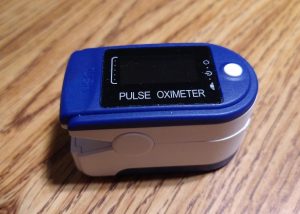According to Johns Hopkins Medicine, COVID-19 manifests itself as a respiratory disease that can cause lung complications including pneumonia and acute respiratory distress, both of which deplete oxygen levels in the body. According to Dr. Richard Levitan, who wrote a related op-ed in the New York Times, some COVID patients either do not notice or do not have other illness symptoms as their oxygen levels drop. However, he said that using Pulse Oximeters can help individuals recognize signs of COVID-19 before they notice any other symptoms.
An oximeter is the gadget that gets stuck on your finger whenever you visit a doctor’s office. Most home oximeters run in the $40 to $60 price range. Many people, instead of trying to gauge symptoms solely based on how they feel, would like to see health issues expressed as a number that they can compare to “correct” values. They want a relatively inexpensive device to provide the numbers, and even better if it can detect viral symptoms before they can feel them.
Johns Hopkins’ Dr. Patricia Conrad-Rizzo suggests avoiding phone apps that claim to work as pulse oximeters, unless your doctor tells you otherwise. The traditional oximeters and phone apps work by different technologies. There are pulse oximeters capable of linking to a phone app to record a series of measurements, so these are medically fine, though you pay more for that feature.
Dr. Conrad-Rizzo recommends speaking with your physician to get more understanding about the meaning of the numbers. The more information you have about the range of numbers that the oximeter provides over time, the better you are able to decide if you need to do something about a reading. And you may be able to relate it to how you are feeling.
We’ve discussed what pulse oximeters measure and how they work. Now we need to talk about the normal ranges for heart rate and oxygen saturation.
- Heart rate — 60-100 beats/min
- Oxygen Saturation — 95-100%
Keep in mind that these are the normal values for an average adult. The ranges may vary depending on your age and health. And while the normal range for oxygen saturation is 95-100%, the level isn’t considered to be dangerously low until it drops below 90%. That is referred to as hypoxemia, which means that there is an abnormally low level of oxygen in the blood. Hypoxemia is treated with supplemental oxygen.
How to get an accurate reading
Pulse oximeters use two specific light wavelengths, with the reading viewed through a transparent acrylic panel screen. That reflects some of the ambient light, which lets people judge whether the environment is suitable for measurement. Strong room lighting can affect measurement results. Follow the instructions which come with your pulse oximeter. They may include:
- Dark nail polish may produce a false reading.
- An oxygen saturation level of about 95% is considered normal. Saturation levels below 92% are considered below average.
- Don’t use a pulse oximeter if your fingers are cold after being outside. Warm up your fingers first for a proper reading.
- The index, middle and ring fingers are recommended as good monitor positions.
- If your oxygenation levels are poor according to your pulse oximeter, don’t panic. Pay attention to any other symptoms you may be having, and if needed, seek immediate medical attention.
- Some pulse oximeters read your pulse rate as they read your blood oxygenation level. Track this data for your doctor, too.
- Avoid smoking on days you’re taking pulse oximeter readings. The chemicals in cigarettes can cause false readings with some pulse oximeters.
Below is a picture of a typical pulse oximeter.

Note: This article only provides general information about pulse oximeters. This information is NOT medical advice. Check with your physician about how to interpret your pulse oximeter readings and your normal reading.
